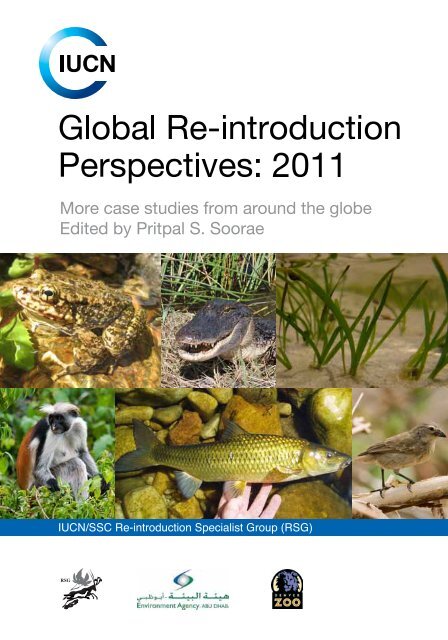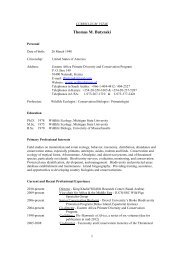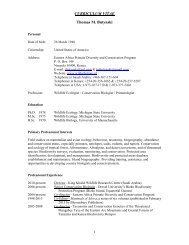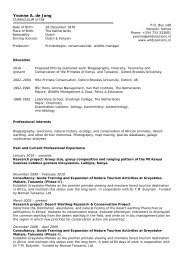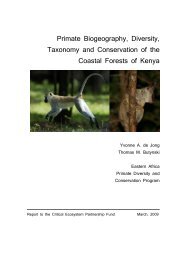Zanzibar red colobus on Pemba Island, Tanzania - Wild Solutions
Zanzibar red colobus on Pemba Island, Tanzania - Wild Solutions
Zanzibar red colobus on Pemba Island, Tanzania - Wild Solutions
Create successful ePaper yourself
Turn your PDF publications into a flip-book with our unique Google optimized e-Paper software.
The designati<strong>on</strong> of geographical entities in this book, and the presentati<strong>on</strong> of the material,<br />
do not imply the expressi<strong>on</strong> of any opini<strong>on</strong> whatsoever <strong>on</strong> the part of IUCN or any of the<br />
funding organizati<strong>on</strong>s c<strong>on</strong>cerning the legal status of any country, territory, or area, or of its<br />
authorities, or c<strong>on</strong>cerning the delimitati<strong>on</strong> of its fr<strong>on</strong>tiers or boundaries.<br />
The views expressed in this publicati<strong>on</strong> do not necessarily reflect those of IUCN.<br />
Published by: IUCN/SSC Re-introducti<strong>on</strong> Specialist Group & Envir<strong>on</strong>ment Agency-ABU<br />
DHABI<br />
Copyright:<br />
© 2011 Internati<strong>on</strong>al Uni<strong>on</strong> for the C<strong>on</strong>servati<strong>on</strong> of Nature and Natural<br />
Resources<br />
Citati<strong>on</strong>: Soorae, P. S. (ed.) (2011). Global Re-introducti<strong>on</strong> Perspectives: 2011.<br />
More case studies from around the globe. Gland, Switzerland: IUCN/SSC<br />
Re-introducti<strong>on</strong> Specialist Group and Abu Dhabi, UAE: Envir<strong>on</strong>ment<br />
Agency-Abu Dhabi. xiv + 250 pp.<br />
ISBN: 978-2-8317-1432-5<br />
Cover photo: Clockwise starting from top-left:<br />
i. Mountain yellow-legged frog © Adam Backlin<br />
ii. American alligator © Ruth Elsey<br />
iii. Dwarf eelgrass © Laura Govers, RU Nijmegen<br />
iv. Mangrove finch © Michael Dvorak BirdLife Austria<br />
v. Berg-Breede whitefish © N. Dean Imps<strong>on</strong><br />
vi. <str<strong>on</strong>g>Zanzibar</str<strong>on</strong>g> <str<strong>on</strong>g>red</str<strong>on</strong>g> <str<strong>on</strong>g>colobus</str<strong>on</strong>g> m<strong>on</strong>key © Tom Butynski & Yv<strong>on</strong>ne de J<strong>on</strong>g<br />
Cover design<br />
& layout by:<br />
Pritpal S. Soorae, IUCN/SSC Re-introducti<strong>on</strong> Specialist Group<br />
Produced by: IUCN/SSC Re-introducti<strong>on</strong> Specialist Group & Envir<strong>on</strong>ment Agency-ABU<br />
DHABI<br />
Download at: www.iucnsscrsg.org<br />
iii
Mammals<br />
<str<strong>on</strong>g>Zanzibar</str<strong>on</strong>g> <str<strong>on</strong>g>red</str<strong>on</strong>g> <str<strong>on</strong>g>colobus</str<strong>on</strong>g> <strong>on</strong> <strong>Pemba</strong> <strong>Island</strong>, <strong>Tanzania</strong>:<br />
populati<strong>on</strong> status 38 years post-introducti<strong>on</strong><br />
Thomas M. Butynski 1,2 & Yv<strong>on</strong>ne A. de J<strong>on</strong>g 2<br />
1<br />
Zoological Society of L<strong>on</strong>d<strong>on</strong>, Director, King Khalid <strong>Wild</strong>life Research Center,<br />
P. O. Box 61681, Riyadh 11575, Kingdom of Saudi Arabia tbutynski@aol.com<br />
2<br />
Co-Director, Eastern Africa Primate Diversity and C<strong>on</strong>servati<strong>on</strong> Program,<br />
P. O. Box 149, 10400 Nanyuki, Kenya yv<strong>on</strong>ne@wildsoluti<strong>on</strong>s.nl<br />
Introducti<strong>on</strong><br />
The <str<strong>on</strong>g>Zanzibar</str<strong>on</strong>g> <str<strong>on</strong>g>red</str<strong>on</strong>g> <str<strong>on</strong>g>colobus</str<strong>on</strong>g> m<strong>on</strong>key (Pro<str<strong>on</strong>g>colobus</str<strong>on</strong>g> kirkii; adult body weight c. 7 kg) is<br />
an arboreal, folivorous, forest m<strong>on</strong>key that is endemic to <str<strong>on</strong>g>Zanzibar</str<strong>on</strong>g> (Unguja) <strong>Island</strong><br />
(2,461 km²), <strong>Tanzania</strong>. Pro<str<strong>on</strong>g>colobus</str<strong>on</strong>g> kirkii is <strong>on</strong>e of Africa’s most threatened<br />
species of primate with but 2,000 - 2,500 individuals remaining (Struhsaker &<br />
Siex, 1998; Struhsaker, 2010). According to the current IUCN Red List of<br />
Threatened Animals, P. kirkii is an ‘Endange<str<strong>on</strong>g>red</str<strong>on</strong>g>’ species. Pro<str<strong>on</strong>g>colobus</str<strong>on</strong>g> kirkii is also<br />
a CITES II species. About half of the P. kirkii <strong>on</strong> <str<strong>on</strong>g>Zanzibar</str<strong>on</strong>g> reside outside protected<br />
areas where they are threatened by habitat degradati<strong>on</strong>, destructi<strong>on</strong>, and<br />
fragmentati<strong>on</strong> due to logging, charcoal producti<strong>on</strong> and clearing of forest for<br />
cultivati<strong>on</strong>. There is no captive populati<strong>on</strong>.<br />
Fifteen P. kirkii (5 males:10 females) were introduced in 1973 to Ngezi-<br />
Vumawimbi Nature Forest Reserve, north-western <strong>Pemba</strong> <strong>Island</strong>, <strong>Tanzania</strong>, by<br />
the <str<strong>on</strong>g>Zanzibar</str<strong>on</strong>g> Forestry Department<br />
(Maulid Hamad, pers. comm.).<br />
These animals were captu<str<strong>on</strong>g>red</str<strong>on</strong>g> <strong>on</strong><br />
<str<strong>on</strong>g>Zanzibar</str<strong>on</strong>g>, c. 150 km from Ngezi<br />
Forest. <strong>Pemba</strong> is an oceanic island<br />
located c. 50 km off the mainland.<br />
Prior to human occupati<strong>on</strong>, <strong>Pemba</strong><br />
was almost entirely cove<str<strong>on</strong>g>red</str<strong>on</strong>g> with<br />
forest. Today, given the high<br />
density of people and intensive<br />
agriculture, <strong>on</strong>ly about 5% of the<br />
original forest remains.<br />
N<strong>on</strong>etheless, <strong>Pemba</strong> c<strong>on</strong>tinues to<br />
hold a rich and unique flora and<br />
fauna which includes many<br />
endemic and threatened species<br />
(Pakenham, 1984; Beentje, 1990;<br />
Nah<strong>on</strong>yo et al., 2005).<br />
Adult female <str<strong>on</strong>g>Zanzibar</str<strong>on</strong>g> <str<strong>on</strong>g>red</str<strong>on</strong>g><br />
<str<strong>on</strong>g>colobus</str<strong>on</strong>g> m<strong>on</strong>key<br />
© Tom Butynski & Yv<strong>on</strong>ne de J<strong>on</strong>g<br />
Goals<br />
Goal 1: This release occur<str<strong>on</strong>g>red</str<strong>on</strong>g><br />
38 years ago. We have not found<br />
any documentati<strong>on</strong> as c<strong>on</strong>cerns<br />
168
Mammals<br />
this introducti<strong>on</strong>, and therefore, it is not known what ‘success indicators’<br />
Forestry Department had in mind. We do know, however, that this was an<br />
introducti<strong>on</strong> for the purpose of enhancing the l<strong>on</strong>g-term survival of P. kirkii and<br />
that this was followed in 1977 - 1978 by translocati<strong>on</strong>s (probably reintroducti<strong>on</strong>s)<br />
<strong>on</strong> <str<strong>on</strong>g>Zanzibar</str<strong>on</strong>g> itself, into Mayingini Forest Reserve (9 animals),<br />
Masingini Forest Reserve (23 animals), and Kichweli Forest Reserve (13<br />
animals; Silkiluwasha, 1981). It seems obvious, therefore, that the primary<br />
goal was to establish a new, self-sustaining, populati<strong>on</strong> of P. kirkii <strong>on</strong> <strong>Pemba</strong><br />
<strong>Island</strong> that would persist into the distant future and c<strong>on</strong>tribute significantly to<br />
the l<strong>on</strong>g-term survival of the species.<br />
Goal 2: A probable goal was to develop an efficient and inexpensive method<br />
for capturing and translocating P. kirkii while also minimizing mortality.<br />
Goal 3: A probable goal was to promote local, nati<strong>on</strong>al and internati<strong>on</strong>al<br />
awareness of the threats to the survival of P. kirkii and, thereby, influence<br />
public opini<strong>on</strong> and foster support not <strong>on</strong>ly for the c<strong>on</strong>servati<strong>on</strong> of P. kirkii but<br />
also for Ngezi-Vumawimbi Nature Forest Reserve and its biodiversity.<br />
Goal 4: A probable goal was to improve the image of the <str<strong>on</strong>g>Zanzibar</str<strong>on</strong>g> Forestry<br />
Department as a c<strong>on</strong>servati<strong>on</strong> body.<br />
Success indicators<br />
The pre-implementati<strong>on</strong> success indicators are not known, but they, presumably,<br />
included the following:<br />
Indicator 1: The new populati<strong>on</strong> is self<br />
-sustaining and persistent (for<br />
centuries).<br />
Indicator 2: The new populati<strong>on</strong><br />
increases in size so as to c<strong>on</strong>tribute<br />
significantly to the global populati<strong>on</strong><br />
and c<strong>on</strong>servati<strong>on</strong> of P. kirkii.<br />
Indicator 3: Capture and translocati<strong>on</strong><br />
methods are developed that are<br />
practical, inexpensive, and that result<br />
in low mortality.<br />
Indicator 4: Public awareness of the<br />
plight of P. kirkii is raised <strong>on</strong> <str<strong>on</strong>g>Zanzibar</str<strong>on</strong>g>,<br />
<strong>Pemba</strong>, and internati<strong>on</strong>ally.<br />
Project Summary<br />
Feasibility: Ngezi-Vumawimbi Nature<br />
Forest Reserve (20 km²), gazetted in<br />
1923, encompasses the <strong>on</strong>ly moist forest<br />
(c. 10 km²) <strong>on</strong> <strong>Pemba</strong> that is of any size.<br />
Elevati<strong>on</strong> is c. 0 - 30 m a.s.l. Soils are<br />
deep, rich, alluvial sands. The climate is<br />
hot and humid. Temperatures range from<br />
c. 21 - 34°C. Mean annual rainfall is c.<br />
1,860 mm. The wettest m<strong>on</strong>ths are<br />
March - May and November -<br />
<strong>Pemba</strong> palm: an endemic species<br />
important for the survival of <str<strong>on</strong>g>colobus</str<strong>on</strong>g><br />
© Yv<strong>on</strong>ne de J<strong>on</strong>g & Tom Butynski<br />
169
Mammals<br />
December. The moist forest of Ngezi has been described by Beentje (1990) as<br />
showing “…an assemblage of species that is not paralleled in any other East<br />
African forest…” and as “…unique in a global sense”. Ngezi Forest is important<br />
for the c<strong>on</strong>servati<strong>on</strong> of at least six species of plants and 13 species of vertebrates<br />
that are endemic to <strong>Pemba</strong> <strong>Island</strong>, plus a good number of endemic subspecies<br />
and near endemic species, many of which are threatened with extincti<strong>on</strong><br />
(Pakenham, 1984; Beentje, 1990; Nah<strong>on</strong>yo et al., 2005). It is not known what<br />
c<strong>on</strong>siderati<strong>on</strong>, if any, was given to the impact that an introduced populati<strong>on</strong> of P.<br />
kirkii might have <strong>on</strong> the other (many) species in Ngezi Forest, or <strong>on</strong> the<br />
ecosystem as a whole. This m<strong>on</strong>key is not c<strong>on</strong>side<str<strong>on</strong>g>red</str<strong>on</strong>g> to be an important pest of<br />
crops.<br />
The <strong>Tanzania</strong> Populati<strong>on</strong> Census of 2002 found 20,138 people in the 10 villages<br />
that are closest to Ngezi Forest. The annual rate of growth of this human<br />
populati<strong>on</strong> was 5.4% in 2002, which is <strong>on</strong>e of the highest in Africa. Most of the<br />
land outside of the Ngezi-Vumawimbi Nature Forest Reserve has been clea<str<strong>on</strong>g>red</str<strong>on</strong>g> of<br />
forest and put under intensive agriculture (mainly cassava, sweet potato, coc<strong>on</strong>ut,<br />
millet, rice, and banana). Approximately 80% of the local income is derived from<br />
farming and 10% from fishing. About 59% of the people keep cattle and 30%<br />
keep goats. Many of the local people use the forest, particularly for firewood and<br />
timber (Nah<strong>on</strong>yo et al., 2005).<br />
Implementati<strong>on</strong>: This represents <strong>on</strong>e of the first attempts (if not the first attempt)<br />
to translocate or introduce an African primate for the purpose of c<strong>on</strong>servati<strong>on</strong>. No<br />
records were found of where <strong>on</strong> <str<strong>on</strong>g>Zanzibar</str<strong>on</strong>g>, or how, the P. kirkii translocated to<br />
Ngezi Forest were captu<str<strong>on</strong>g>red</str<strong>on</strong>g>. As for all of the several captures made during 1977 -<br />
1978, the site of the 1973 capture was probably either a poor habitat for P. kirkii<br />
or a good habitat that was being clea<str<strong>on</strong>g>red</str<strong>on</strong>g> for agriculture (Silkiluwasha, 1981). It is<br />
also likely that the capture method was the same as used during 1977 - 1978 for<br />
translocati<strong>on</strong>s within <str<strong>on</strong>g>Zanzibar</str<strong>on</strong>g>. See Silkiluwasha (1981) for details of the capture<br />
method and holding cages. Of 40 P. kirkii captu<str<strong>on</strong>g>red</str<strong>on</strong>g> using this method in 1977 -<br />
1978, four (10%) died prior to release.<br />
There is no informati<strong>on</strong> <strong>on</strong> whether the P. kirkii captu<str<strong>on</strong>g>red</str<strong>on</strong>g> <strong>on</strong> <str<strong>on</strong>g>Zanzibar</str<strong>on</strong>g> for release<br />
in Ngezi Forest were quarantined and/or given health checks, but this seems<br />
unlikely. On <str<strong>on</strong>g>Zanzibar</str<strong>on</strong>g>, P. kirkii were usually released <strong>on</strong> the same day that they<br />
were captu<str<strong>on</strong>g>red</str<strong>on</strong>g>. Pro<str<strong>on</strong>g>colobus</str<strong>on</strong>g> do poorly in captivity (Silkiluwasha, 1981; Struhsaker<br />
& Siex, 1998) so it seems unlikely that those bound for Ngezi Forest were held<br />
any l<strong>on</strong>ger than necessary prior to release. Whether they were moved to <strong>Pemba</strong><br />
by air or by sea is not known. It is also not known how many, if any, died during<br />
the capture or translocati<strong>on</strong>. Maulid Hamad (pers. comm.), who was present at<br />
the time of the release, said that all 15 P. kirkii were released at <strong>on</strong>e site (Josh).<br />
Post-release m<strong>on</strong>itoring: There seems to be no informati<strong>on</strong>, prior to 1991,<br />
c<strong>on</strong>cerning post-release m<strong>on</strong>itoring of P. kirkii in Ngezi Forest. Censuses of this<br />
populati<strong>on</strong> were c<strong>on</strong>ducted in 1991, 1992 (Struhsaker & Siex, 1998), 2000 (Ciani<br />
et al., 2001), 2005 (Nah<strong>on</strong>yo et al., 2005), and 2011 (this study). The 1991, 1992,<br />
2000 and 2005 censuses each encounte<str<strong>on</strong>g>red</str<strong>on</strong>g> no more than <strong>on</strong>e group of P. kirkii<br />
170
Mammals<br />
and the largest group comprised <strong>on</strong>ly six animals. Although the 2000 census<br />
located <strong>on</strong>ly <strong>on</strong>e group of (at least three) P. kirkii, interviews with local people<br />
suggested that two other groups (of 5 - 8 and 5 - 7 animals) occur<str<strong>on</strong>g>red</str<strong>on</strong>g> in Ngezi<br />
Forest. A fourth group of 4 - 6 animals was said to be present in an aband<strong>on</strong>ed<br />
clove plantati<strong>on</strong> c. 6 km south of Ngezi Forest. The c<strong>on</strong>clusi<strong>on</strong> of the 2000 census<br />
is that there were 15 - 30 P. kirkii in Ngezi Forest.<br />
During the 2011 census (5 days; 53 hrs of census by two primatologists) we<br />
located two groups (of at least 7 and 8 animals) and found str<strong>on</strong>g evidence<br />
(leaves from which the petiole had been bitten-off) for three additi<strong>on</strong>al groups. We<br />
c<strong>on</strong>clude that there are likely no fewer than 35 P. kirkii in Ngezi Forest, with the<br />
actual number perhaps closer to 40. There were no reports of P. kirkii at any other<br />
sites <strong>on</strong> <strong>Pemba</strong>. Thus, 38 years after the introducti<strong>on</strong> to <strong>Pemba</strong>, the populati<strong>on</strong><br />
has more than doubled, but c<strong>on</strong>tinues to be small. The five groups were widely<br />
scatte<str<strong>on</strong>g>red</str<strong>on</strong>g> across Ngezi Forest with the shortest distance between groups being<br />
700 m and the farthest distance being 6 km. Groups appear to have an affinity for<br />
forest edge next to, or over, water (e.g., forest-mangrove ecot<strong>on</strong>e, swamp forest).<br />
Major difficulties faced<br />
Insufficient informati<strong>on</strong>: The absence of any m<strong>on</strong>itoring during the first 17<br />
years (1973 - 1990) post-release, and of a low level of m<strong>on</strong>itoring over the<br />
past 21 years (1990 - 2011), greatly limits what can be learned from this<br />
introducti<strong>on</strong>. For example, we do not know the rates of growth or decline of<br />
this populati<strong>on</strong>, nor the problems that this populati<strong>on</strong> encounte<str<strong>on</strong>g>red</str<strong>on</strong>g>. A detailed<br />
census needs to be c<strong>on</strong>ducted of this populati<strong>on</strong> so that its size, age/sex<br />
compositi<strong>on</strong>, and distributi<strong>on</strong> are better understood. Detailed censuses should<br />
then be repeated at least <strong>on</strong>ce every 5 years. Intensive ecological studies<br />
should be undertaken <strong>on</strong> this populati<strong>on</strong> with the objectives of better<br />
understanding what impact P. kirkii is having <strong>on</strong> the ecosystem and what<br />
factors are most limiting populati<strong>on</strong> growth. Genetics research (using fecal<br />
samples) needs to be c<strong>on</strong>ducted in order to assess the level of inbreeding and<br />
the need for translocating new animals into this populati<strong>on</strong> (see next bullet<br />
point). The genetic diversity of this populati<strong>on</strong> should be regularly m<strong>on</strong>ito<str<strong>on</strong>g>red</str<strong>on</strong>g> in<br />
order to assess the need for translocati<strong>on</strong>s.<br />
Probable inbreeding depressi<strong>on</strong>: Given the size of Ngezi Forest, and the high<br />
diversity of plant species, it seems unlikely that food is limiting this populati<strong>on</strong>.<br />
At present, P. kirkii probably occupy less than 10% of that part of Ngezi Forest<br />
that is cove<str<strong>on</strong>g>red</str<strong>on</strong>g> by moist forest (c. 10 km²). Now, 38 years (about four<br />
generati<strong>on</strong>s) post-release, this populati<strong>on</strong> (which is based <strong>on</strong> <strong>on</strong>ly 15<br />
founders), may be suffering from inbreeding depressi<strong>on</strong>. If the present<br />
objective is to maintain the l<strong>on</strong>g-term viability of this isolated populati<strong>on</strong>, then<br />
at least <strong>on</strong>e supplemental release of P. kirkii from <str<strong>on</strong>g>Zanzibar</str<strong>on</strong>g> is warranted as<br />
this should help to over-come what may be a genetic bottleneck. Individuals <strong>on</strong><br />
<str<strong>on</strong>g>Zanzibar</str<strong>on</strong>g> that are likely to perish due to habitat loss are the most suitable<br />
candidates. The number to translocate, and the time frame, need to be<br />
determined, but even a small number might c<strong>on</strong>tribute significantly towards out<br />
-breeding the Ngezi Forest populati<strong>on</strong>.<br />
171
Mammals<br />
Hunting: Poaching has<br />
been put forth as the<br />
reas<strong>on</strong> for the low<br />
numbers of P. kirkii in<br />
Ngezi Forest (Nah<strong>on</strong>yo et<br />
al., 2005). While we found<br />
no evidence of hunting<br />
during our census, the<br />
possible impact of hunting<br />
cannot be discounted,<br />
particularly given the small<br />
size of this populati<strong>on</strong> and<br />
that three of the larger<br />
species that are said to<br />
have <strong>on</strong>ce been comm<strong>on</strong>/<br />
abundant in Ngezi Forest<br />
<strong>Pemba</strong> vervet m<strong>on</strong>key is endemic to <strong>Pemba</strong> <strong>Island</strong>, are now either at low<br />
density or, perhaps,<br />
Ngezi Forest © Yv<strong>on</strong>ne de J<strong>on</strong>g & Tom Butynski<br />
extirpated; <strong>Pemba</strong> blue<br />
duiker (Philantomba<br />
m<strong>on</strong>ticola pembae), wild boar (Sus scrofa), and <str<strong>on</strong>g>Zanzibar</str<strong>on</strong>g> tree hyrax<br />
(Dendrohyrax validus neumanni) (Pakenham, 1984; Nah<strong>on</strong>yo et al., 2005; T.<br />
Butynski & Y. de J<strong>on</strong>g, pers. obs.).<br />
Difficult to census: Unlike other populati<strong>on</strong>s of Pro<str<strong>on</strong>g>colobus</str<strong>on</strong>g>, P. kirkii <strong>on</strong> <strong>Pemba</strong><br />
are surprisingly difficult to locate and count. This is a relatively quiet, inactive,<br />
m<strong>on</strong>key that is often high and well-hidden in the canopy of tall trees (>30 m) or<br />
else low (
Mammals<br />
populati<strong>on</strong> comprised c. 60 animals. This is a 67% increase during the 13 - 17<br />
years post-introducti<strong>on</strong> (Struhsaker & Siex, 1998). This populati<strong>on</strong> was still<br />
present in April 2011 (T. Butynski & Y. de J<strong>on</strong>g, pers. obs.).<br />
Suitable capture method exists: The method for capturing and translocating P.<br />
kirkii, as described by Silkiluwasha (1981) for the 1977 - 1978 translocati<strong>on</strong>s<br />
within <str<strong>on</strong>g>Zanzibar</str<strong>on</strong>g>, is effective, inexpensive, and mortality is low at about 10% (4<br />
of 40 captu<str<strong>on</strong>g>red</str<strong>on</strong>g> animals died). Whether mortality was similar for the Ngezi<br />
Forest introducti<strong>on</strong> is not known but might have been higher given the greater<br />
distance (c. 150 km) between the capture site and the release site.<br />
L<strong>on</strong>g-term m<strong>on</strong>itoring scheme is requi<str<strong>on</strong>g>red</str<strong>on</strong>g>: Without a good post-release<br />
m<strong>on</strong>itoring program in place, the opportunity to obtain informati<strong>on</strong> useful to<br />
improving the introducti<strong>on</strong> process and post-introducti<strong>on</strong> management of the<br />
populati<strong>on</strong>, and of assessing the impact of the introduced populati<strong>on</strong> <strong>on</strong> the<br />
ecosystem, is lost. A l<strong>on</strong>g-term m<strong>on</strong>itoring scheme needs to be put into place.<br />
Enhance benefits to local people: More benefits to local people through ecotourism<br />
in Ngezi Forest, perhaps with a focus <strong>on</strong> viewing P. kirkii, should bring<br />
additi<strong>on</strong>al c<strong>on</strong>servati<strong>on</strong> support from the local community and foster a sense of<br />
pride and resp<strong>on</strong>sibility for the c<strong>on</strong>servati<strong>on</strong> of Ngezi Forest, its biodiversity,<br />
and its populati<strong>on</strong> of P. kirkii.<br />
Success of project<br />
Highly Successful Successful Partially Successful Failure<br />
<br />
Reas<strong>on</strong>(s) for success/failure:<br />
The introduced P. kirkii were placed into what is probably a food-rich habitat;<br />
Ngezi Forest is larger and far more botanically-rich than any forest <strong>on</strong><br />
<str<strong>on</strong>g>Zanzibar</str<strong>on</strong>g>. The altitude and climate (including rainfall) are similar <strong>on</strong> <strong>Pemba</strong> and<br />
<str<strong>on</strong>g>Zanzibar</str<strong>on</strong>g>.<br />
There are <strong>on</strong>ly two species of primate indigenous to <strong>Pemba</strong> and neither is a<br />
competitor with P. kirkii; <strong>Pemba</strong> vervet m<strong>on</strong>key (Cercopithecus pygerythrus<br />
nesiotes) and <str<strong>on</strong>g>Zanzibar</str<strong>on</strong>g> small-ea<str<strong>on</strong>g>red</str<strong>on</strong>g> galago (Otolemur garnettii garnettii).<br />
There are no significant n<strong>on</strong>-human p<str<strong>on</strong>g>red</str<strong>on</strong>g>ators of m<strong>on</strong>keys <strong>on</strong> <strong>Pemba</strong>, such as<br />
African crowned eagle (Stephanoaetus cor<strong>on</strong>atus), robust chimpanzee (Pan<br />
troglodytes), leopard (Panthera pardus), or central African rock pyth<strong>on</strong> (Pyth<strong>on</strong><br />
sebae).<br />
Pro<str<strong>on</strong>g>colobus</str<strong>on</strong>g> kirkii is not known to be a serious pest of crops and the hunting of<br />
m<strong>on</strong>keys for bushmeat is not an important part of the culture of the people of<br />
<strong>Pemba</strong>, the vast majority of whom are Muslim (Muslims typically do not eat<br />
m<strong>on</strong>keys).<br />
There seems to be a steady increase in the local, nati<strong>on</strong>al and internati<strong>on</strong>al<br />
commitment to the c<strong>on</strong>servati<strong>on</strong> of Ngezi Forest and P. kirkii. Forestry<br />
Department, with support from outside agencies (e.g., CARE, FINNIDA) has<br />
c<strong>on</strong>tinued to improve the protecti<strong>on</strong> and management of Ngezi Forest.<br />
173
Mammals<br />
Acknowledgements<br />
Support for the 2011 census came from the <str<strong>on</strong>g>Zanzibar</str<strong>on</strong>g> Department of Commercial Crops,<br />
Fruits, and Forestry, Margot Marsh Biodiversity Foundati<strong>on</strong>, C<strong>on</strong>servati<strong>on</strong> Internati<strong>on</strong>al,<br />
Zoo Atlanta, The Dian Fossey Gorilla Fund Internati<strong>on</strong>al, and the Zoological Society of<br />
L<strong>on</strong>d<strong>on</strong>. We thank Tara Stoinski, Asseid Bakari, Russ Mittermeier, Anth<strong>on</strong>y Rylands, Jean-<br />
Pierre Dekker, Ella Outlaw, Kassim Hamza Madeweya, Said Juma, Mwadini Haji Makame,<br />
Juma Khamis, Maulid Hamad, Fatma Mbarouk, Sharif Faki Sharit, Salum Hamadi, and<br />
Mashud Njuma for helping to make this census possible, and Lorna Depew for reviewing<br />
the manuscript.<br />
References<br />
Beentje, H. J. 1990. Botanical assessment of Ngezi Forest, <strong>Pemba</strong>. Unpublished<br />
report for the <str<strong>on</strong>g>Zanzibar</str<strong>on</strong>g> Forestry Development Project of FINNIDA and the Finnish<br />
Nati<strong>on</strong>al Board of Forestry.<br />
Ciani, A. C., Palentini, L. & Finotto, E. 2001. Survival of a small translocated<br />
Pro<str<strong>on</strong>g>colobus</str<strong>on</strong>g> kirkii populati<strong>on</strong> <strong>on</strong> <strong>Pemba</strong> <strong>Island</strong>. Animal Biodiversity and<br />
C<strong>on</strong>servati<strong>on</strong> 24: 15 - 18.<br />
Nah<strong>on</strong>yo, C. L., Mwasumbi, L. B., Msuya, C. A., Masao, C. A., Suya, T. B. &<br />
Shing’wenda, C. 2005. Ngezi–Vumawimbi Forest Reserves biodiversity inventory<br />
report. Unpublished report for Care <strong>Tanzania</strong> and Department of Commercial<br />
Crops, Fruits and Forestry.<br />
Pakenham, R. H. W. 1984. The mammals of <str<strong>on</strong>g>Zanzibar</str<strong>on</strong>g> and <strong>Pemba</strong> <strong>Island</strong>s.<br />
Unpublished report, Harpenden, Herts, England.<br />
Silkiluwasha, F. 1981. The distributi<strong>on</strong> and c<strong>on</strong>servati<strong>on</strong> status of the <str<strong>on</strong>g>Zanzibar</str<strong>on</strong>g><br />
<str<strong>on</strong>g>red</str<strong>on</strong>g> <str<strong>on</strong>g>colobus</str<strong>on</strong>g>. African Journal of Ecology 19: 187 - 194.<br />
Struhsaker, T. T. 2010. The Red Colobus M<strong>on</strong>keys. Oxford University Press,<br />
Oxford. pp. 349.<br />
Struhsaker, T. T. & Siex, K. S. 1998. Translocati<strong>on</strong> and introducti<strong>on</strong> of the<br />
<str<strong>on</strong>g>Zanzibar</str<strong>on</strong>g> <str<strong>on</strong>g>red</str<strong>on</strong>g> <str<strong>on</strong>g>colobus</str<strong>on</strong>g> m<strong>on</strong>key: success and failure with an endange<str<strong>on</strong>g>red</str<strong>on</strong>g> island<br />
endemic. Oryx 32: 277 - 284.<br />
174


